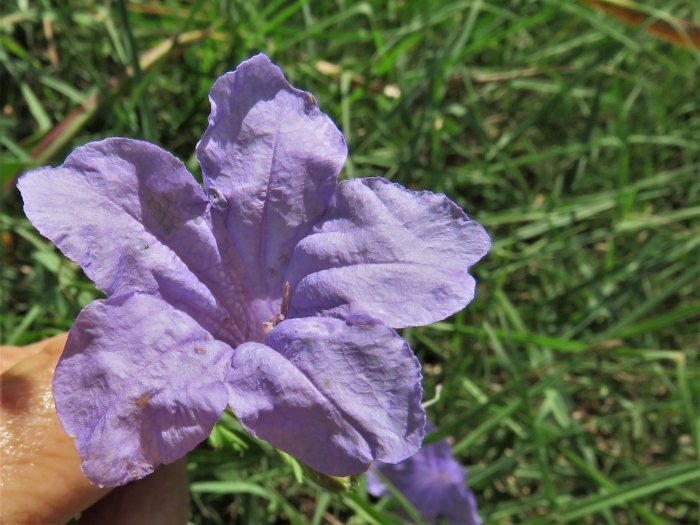Violet Wild Petunia
(Ruellia nudiflora)
Violet Wild Petunia (Ruellia nudiflora)
/
/

Annika Lindqvist
CC BY 4.0
Image By:
Annika Lindqvist
Recorded By:
Copyright:
CC BY 4.0
Copyright Notice:
Photo by: Annika Lindqvist | License Type: CC BY 4.0 | License URL: http://creativecommons.org/licenses/by/4.0/ | Rights Holder: Annika Lindqvist | Publisher: iNaturalist | Date Created: 2018-08-30T15:25:30-07:00 |


















































Estimated Native Range
Summary
Ruellia nudiflora, commonly known as Violet Wild Petunia, is a deciduous perennial subshrub or herb native to open woodlands, forest edges, and grasslands in the Southern and Southwestern United States, Mexico, and Central America. It typically grows to a height of 3-8 feet (0.9-2.4 meters) and a width of 4-8 feet (1.2-2.4 meters). The plant has an upright form with lance-shaped leaves and produces showy, trumpet-shaped purple flowers throughout the spring, summer, and fall, attracting pollinators such as butterflies and hummingbirds.
Violet Wild Petunia is valued for its long blooming period and the vibrant color it adds to the garden. It is used in border plantings, as a ground cover, and in naturalized areas. This species is drought-tolerant once established and can adapt to a range of soil types, although it prefers well-drained soils. It can be grown in full sun to part shade and requires low to medium amounts of water. While generally low-maintenance, it can self-seed prolifically and may become invasive in some areas. Gardeners should be aware of its potential to spread but can manage this by deadheading spent flowers to prevent seed formation.CC BY-SA 4.0
Violet Wild Petunia is valued for its long blooming period and the vibrant color it adds to the garden. It is used in border plantings, as a ground cover, and in naturalized areas. This species is drought-tolerant once established and can adapt to a range of soil types, although it prefers well-drained soils. It can be grown in full sun to part shade and requires low to medium amounts of water. While generally low-maintenance, it can self-seed prolifically and may become invasive in some areas. Gardeners should be aware of its potential to spread but can manage this by deadheading spent flowers to prevent seed formation.CC BY-SA 4.0
Plant Description
- Plant Type: Subshrub, Herb
- Height: 3-8 feet
- Width: 4-8 feet
- Growth Rate: Moderate
- Flower Color: Purple
- Flowering Season: Spring, Summer, Fall
- Leaf Retention: Deciduous
Growth Requirements
- Sun: Full Sun, Part Shade
- Water: Low, Medium
- Drainage: Fast, Medium, Slow
Common Uses
Bee Garden, Bird Garden, Butterfly Garden, Deer Resistant, Drought Tolerant, Groundcover, Hummingbird Garden, Low Maintenance, Rock Garden, Showy Flowers
Natural Habitat
native to open woodlands, forest edges, and grasslands in the Southern and Southwestern United States, Mexico, and Central America
Other Names
Common Names: Wild Petunia, Fleur Petard, Triquitraque
Scientific Names: , Ruellia nudiflora, Ruellia occidentalis, Ruellia yucatana, Dipteracanthus nudiflorus, Ruellia nudiflora var. nudiflora, Ruellia nudiflora var. yucatana, Ruellia nudiflora var. glabrata, Ruellia nudiflora var. occidentalis, Ruellia nudiflora var. congesta
GBIF Accepted Name: Ruellia nudiflora (Engelm. & Gray) Urb.